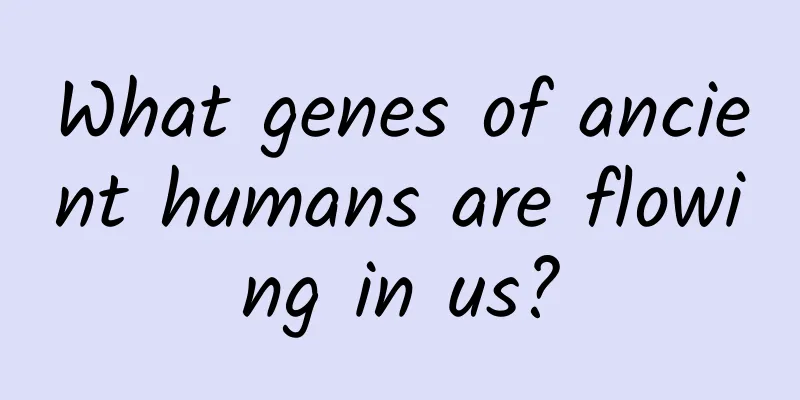What genes of ancient humans are flowing in us?

|
Homo is a genus of the family Hominidae in the order Primates. The current Homo sapiens, or us humans, are the only surviving species of this genus. From the original Australopithecus to modern Homo sapiens, there have been many transitional species. Three species must be mentioned: Denisovans, Neanderthals, and ancient modern humans (Homo sapiens). Denisovans, Neanderthals and Homo sapiens are the most closely related in evolution. Data show that Homo sapiens, the ancestors of modern humans, lived on the same continent with Denisovans and Neanderthals for a long time. These three subspecies of people all flourished in ancient times and were closely connected with each other. However, in the end, only Homo sapiens managed to survive and evolve into modern humans. More and more evidence shows that many Neanderthal and Denisovan genes are still retained in the genomes of modern humans. All this is thanks to the development of archaeology and modern molecular biology sequencing in recent years, which has provided researchers with relatively rich genomic information of the three ancient human species. Neanderthals, like modern humans, even have complete whole genome information. From the comparison information of these genomes, we can see the close connection between the extinct Neanderthals, Denisovans and modern humans. Part 1 Chaotic fusion of populations: Are modern humans actually a hybrid species? In the history of human evolution described by scientists, after leaving Africa, African Homo sapiens (ancestors of modern humans) encountered Neanderthals living in ancient Europe. Subsequently, the two populations lived in a chaotic group and formed a transitional population. However, due to the genetic disadvantages of Neanderthals, they eventually became extinct. In the same year, an article in Nature magazine published the full genome information of Neanderthals. Genetic comparative analysis found that at least 1 to 4% of the genes of most modern people outside of Africa (including Europeans, Asians, Americans and Oceanians) originated from Neanderthals, while modern people in Africa south of the Sahara Desert do not have these genes. About 3%-6% of Denisovan genes (0.2% in the Asian genome) eventually remained in the modern human genome, while Neanderthals had about 1.5%-2.1%. (Image source: Reference [1]) In Europe, many ancient human races have indeed been discovered, and their genetic information is similar to that of Neanderthals to varying degrees, with the highest similarity being 8% and the lowest being only 1%. Similarly, in the extinct Neanderthals, ancient modern human genes were found at a concentration of 1%-7%. These data came from a Neanderthal cave in the Altai Mountains in 2016, dating back about 100,000 years. Part 2 The shadow of genetic disease: Neanderthal genetic legacy A 2016 article in Science magazine (reference [2]) carefully analyzed Neanderthal genes in modern humans. These genes include but are not limited to genes that affect depression, mood, obesity, skin damage, and preference for tobacco. For example, the SLC35F3 gene encodes a vitamin B1 transporter. Studies have shown that the SLC35F3 gene is one of the potential genes for hypertension and high blood pressure. The STMI1 gene encodes a Ca2+ ion sensing protein. It may be associated with early hematopoiesis, immune deficiency, ectoderm development and tubular myopathy defects. The protein encoded by the SLC6A11 gene is used to transport the important neurotransmitter GABA. This is closely related to human emotional control. There is also a gene that controls the development of skin epidermal cells and regulates the development of keratinocytes. This gene can help the skin adapt to different climate characteristics and ultraviolet radiation. Neanderthal art Part 3 Denisovans: Another source of human genes The relationship between Denisovans and Neanderthals is even closer. In 2018, researchers discovered the skull of an ancient human child. Gene sequencing revealed that she was a girl, half of whose genes belonged to Denisovans (father) and half to Neanderthals (mother). It is not known whether this girl is the earliest hybrid. Denisovan genes are also present in modern human genomes. About 5% of modern Melanesians in Papua New Guinea share genes with Denisovans, possibly because the ancestors of Melanesians met and intermarried with Denisovans in southeastern Asia, and then the ancestors of Melanesians came to Papua New Guinea. An article published in Nature in 2014 (reference [3]) found that the high-altitude genes of Tibetans and Sherpas originated from Denisovans. An international team sequenced the EPAS1 gene of 40 Tibetans and 40 Han Chinese, whose ancestors separated between about 2750 and 5500 years ago. They found that a different fragment of EPAS1 is not found in other humans. They then compared the DNA sequences of Neanderthals and Denisovans, the extinct relatives of humans, and confirmed that the gene originated from Denisovans. The protein expressed by EPAS1 is part of a transcription factor that mediates the expression of several genes that are regulated by oxygen, particularly under low oxygen (hypoxia) conditions. The protein contains a basic helix-loop-helix dimerization domain that is also common to other proteins involved in oxygen stress signaling pathways. EPAS1 is involved in the development of the embryonic heart and is expressed in the endothelial cells of the umbilical cord. EPAS1 maintains the homeostasis of catecholamines during early embryonic development to prevent heart failure. Sherpa Finally, let’s talk about some gossip about Neanderthals, or ancient humans, to further explain why there are so many genes of other human races in the human genome, and why the Neanderthals became extinct. Some researchers with unique ideas sequenced the dental plaque of Neanderthal tooth fossils and found that the dental plaque on some tooth fossils of Neanderthals in the same cave and even in the same period was similar, that is, the microbial composition was similar. It is not difficult to conclude that they maintained the habit of kissing. Many of the Neanderthal skeletal fossils found in another cave were deformed, and there was a high probability that they were deformed children caused by inbreeding (it doesn’t seem quite right to say marriage, but that’s what it means anyway). The researchers therefore speculated that the extinction of the Neanderthals was related to their own uncontrolled promiscuity and the extremely high probability of deformed children caused by inbreeding. There is a term in biology called hybrid vigor. It is conceivable that African Homo sapiens, Neanderthals, Denisovans, or other human species of the same period all had promiscuous intercourse, and the hybrid populations that survived in the end were likely the result of these promiscuous intercourses. Finally, for the sake of all humanity, do not marry close relatives. References: [1] K Prüfer, F Racimo, Patterson, N., F Jay, & Pbo, S. (2013). The complete genome sequence of a Neanderthal from the altai mountains. Nature, 505(7481), 43-49. [2] Simonti, CN, Vernot, B., Bastarache, L., Bottinger, E., Carrell, DS, & Chisholm, RL, et al. (2011). The phenotypic legacy of admixture between modern humans and neandertals. Science, 351(6274), 737. [3] Huerta-Sánchez, E., Jin, X., Asan, Bianba, Z., Peter, BM, Vinckenbosch, N., … Nielsen, R. (2014). Altitude adaptation in Tibetans caused by introgression of Denisovan-like DNA. Nature, 512(7513), 194–197. [3] https://doi.org/10.1073/pnas.2020803118. [4] https://www.bbc.com/future/article/20210112-heres-what-sex-with-neanderthals-was-like. Produced by: China Science Expo x Zhihu Author: Dark Senior Brother (Excellent Answerer of Biology on Zhihu) The article only represents the author's views and does not represent the position of China Science Expo This article was first published in China Science Expo (kepubolan) Please indicate the source of the public account when reprinting Please indicate the source of the reprint. Reprinting without authorization is prohibited. For reprint authorization, cooperation, and submission matters, please contact [email protected] |
<<: World Oceans Day丨Today, let’s get to know this friend in the deep sea again
>>: Marine microbes that "eat" debris: What happens when fungi meet plastic?
Recommend
QQ will launch a new feature to create a unique QID
On November 19, it was reported that QQ is curren...
Baidu wants to disable pop-up dialog windows for mobile promotion. What do you think?
(1). Then don’t use pop-ups. Consider the user ex...
Which Saturday of 2022 is the day for classes during the Qingming Festival holiday? Which specific day will the make-up class be? Attached is the latest arrangement for adjustment of holidays!
The Qingming Festival is just a few days away, an...
GAC Aion: From January to December 2022, Aion's cumulative sales volume reached 271,000 units, a year-on-year increase of 126%.
GAC Aion announced that it delivered 10,206 new c...
The most powerful "poison king" in the snake world is not on land, but in...
About tens of millions of years ago, the ancient ...
How many galaxies and suns are there in the universe? Scientific observations tell you the truth
This article is based on answering similar questi...
On the tenth anniversary of Double 11, a comprehensive summary of strategies and gameplay on major platforms!
Unknowingly, it is already 3 days to the countdow...
How does NetEase Yanxuan operate? What is the winning formula?
NetEase Yanxuan is a boutique shopping e-commerce...
How to do a valuable competitive product analysis?
In order to make a valuable competitive analysis ...
China Association of Automobile Manufacturers: From January to October 2021, the year-on-year decline in fixed asset investment in the automobile manufacturing industry narrowed slightly
According to data released by the National Bureau...
How to create a landing page with high conversion rate? Share 2 pictures!
Unlike traditional industries that can bring prod...
The rule for explosive growth in short video operations!
What kind of short video content can be seen by m...
After 2 years at Tencent, I learned these 15 content operation tips!
Two years ago, I accidentally entered the mobile ...
How do communities attract traffic and convert people?
Everyone is talking about community operation and...









